Nitrite confers protection against myocardial infarction: role of xanthine oxidoreductase, NADPH oxidase and K(ATP) channels
- PMID: 17765919
- PMCID: PMC2735077
- DOI: 10.1016/j.yjmcc.2007.07.057
Nitrite confers protection against myocardial infarction: role of xanthine oxidoreductase, NADPH oxidase and K(ATP) channels
Abstract
Reduction of nitrite to nitric oxide during ischemia protects the heart against injury from ischemia/reperfusion. However the optimal dose of nitrite and the mechanisms underlying nitrite-induced cardioprotection are not known. We determined the ability of nitrite and nitrate to confer protection against myocardial infarction in two rat models of ischemia/reperfusion injury and the role of xanthine oxidoreductase, NADPH oxidase, nitric oxide synthase and K(ATP) channels in mediating nitrite-induced cardioprotection. In vivo and in vitro rat models of myocardial ischemia/reperfusion injury were used to cause infarction. Hearts (n=6/group) were treated with nitrite or nitrate for 15 min prior to 30 min regional ischemia and 180 min reperfusion. Xanthine oxidoreductase activity was measured after 15 min aerobic perfusion and 30 min ischemia. Nitrite reduced myocardial necrosis and decline in ventricular function following ischemia/reperfusion in the intact and isolated rat heart in a dose- or concentration-dependent manner with an optimal dose of 4 mg/kg in vivo and concentration of 10 microM in vitro. Nitrate had no effect on protection. Reduction in infarction by nitrite was abolished by the inhibition of flavoprotein reductases and the molybdenum site of xanthine oxidoreductase and was associated with an increase in activity of xanthine dehydrogenase and xanthine oxidase during ischemia. Inhibition of nitric oxide synthase had no effect on nitrite-induced cardioprotection. Inhibition of NADPH oxidase and K(ATP) channels abolished nitrite-induced cardioprotection. Nitrite but not nitrate protects against infarction by a mechanism involving xanthine oxidoreductase, NADPH oxidase and K(ATP) channels.
Figures
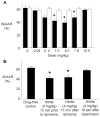
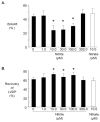
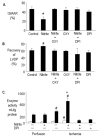
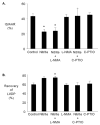
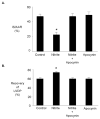
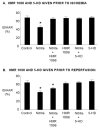
Similar articles
-
Nitrite-derived nitric oxide protects the rat kidney against ischemia/reperfusion injury in vivo: role for xanthine oxidoreductase.J Am Soc Nephrol. 2007 Feb;18(2):570-80. doi: 10.1681/ASN.2006050450. Epub 2007 Jan 3. J Am Soc Nephrol. 2007. PMID: 17202421
-
SCH 79797, a selective PAR1 antagonist, limits myocardial ischemia/reperfusion injury in rat hearts.Basic Res Cardiol. 2007 Jul;102(4):350-8. doi: 10.1007/s00395-007-0653-4. Epub 2007 Apr 30. Basic Res Cardiol. 2007. PMID: 17468933 Free PMC article.
-
Characterization of the magnitude and kinetics of xanthine oxidase-catalyzed nitrate reduction: evaluation of its role in nitrite and nitric oxide generation in anoxic tissues.Biochemistry. 2003 Feb 4;42(4):1150-9. doi: 10.1021/bi026385a. Biochemistry. 2003. PMID: 12549937
-
Putting xanthine oxidoreductase and aldehyde oxidase on the NO metabolism map: Nitrite reduction by molybdoenzymes.Redox Biol. 2018 Oct;19:274-289. doi: 10.1016/j.redox.2018.08.020. Epub 2018 Aug 30. Redox Biol. 2018. PMID: 30196191 Free PMC article. Review.
-
Skeletal muscle as a reservoir for nitrate and nitrite: The role of xanthine oxidase reductase (XOR).Nitric Oxide. 2022 Dec 1;129:102-109. doi: 10.1016/j.niox.2022.10.004. Epub 2022 Oct 28. Nitric Oxide. 2022. PMID: 36367524 Review.
Cited by
-
Nitrate/Nitrite as Critical Mediators to Limit Oxidative Injury and Inflammation.Antioxid Redox Signal. 2015 Aug 1;23(4):328-39. doi: 10.1089/ars.2015.6256. Antioxid Redox Signal. 2015. PMID: 26140517 Free PMC article. Review.
-
Mechanisms of nitrite bioactivation.Nitric Oxide. 2014 Apr 30;38:58-68. doi: 10.1016/j.niox.2013.11.002. Epub 2013 Dec 6. Nitric Oxide. 2014. PMID: 24315961 Free PMC article. Review.
-
A selenium-dependent xanthine dehydrogenase triggers biofilm proliferation in Enterococcus faecalis through oxidant production.J Bacteriol. 2011 Apr;193(7):1643-52. doi: 10.1128/JB.01063-10. Epub 2011 Jan 21. J Bacteriol. 2011. PMID: 21257770 Free PMC article.
-
Nitrite reduction by molybdoenzymes: a new class of nitric oxide-forming nitrite reductases.J Biol Inorg Chem. 2015 Mar;20(2):403-33. doi: 10.1007/s00775-014-1234-2. Epub 2015 Jan 15. J Biol Inorg Chem. 2015. PMID: 25589250 Review.
-
Clinical translation of nitrite therapy for cardiovascular diseases.Nitric Oxide. 2010 Feb 15;22(2):91-7. doi: 10.1016/j.niox.2009.11.001. Epub 2009 Nov 10. Nitric Oxide. 2010. PMID: 19909823 Free PMC article. Review.
References
-
- Shi Y, Hutchins W, Ogawa H, Chang C-C, Pritchard K, Jr, Zhang C, et al. Increased Resistance to Myocardial Ischemia in the Brown Norway vs. Dahl S Rat: Role of Nitric Oxide Synthase and Hsp90. J Mol Cell Cardiol. 2005;38:625–35. - PubMed
-
- Kleinbongard P, Dejam A, Lauer T, Rassaf T, Schindler A, Picker O, et al. Plasma nitrite reflects constitutive nitric oxide synthase activity in mammals. Free Radic Biol Med. 2003;35:790–6. - PubMed
-
- Shiva S, Wang X, Ringwood LA, Xu X, Yuditskaya S, Annavajjhala V, et al. Ceruloplasmin is a NO oxidase and nitrite synthase that determines endocrine NO homeostasis. Nat Chem Biol. 2006;2:486–93. - PubMed
-
- Pelletier MM, Kleinbongard P, Ringwood L, Hito R, Hunter CJ, Schechter AN, et al. The measurement of blood and plasma nitrite by chemiluminescence: pitfalls and solutions. Free Radic Biol Med. 2006;41:541–8. - PubMed
Publication types
MeSH terms
Substances
Grants and funding
LinkOut - more resources
Full Text Sources
Medical

